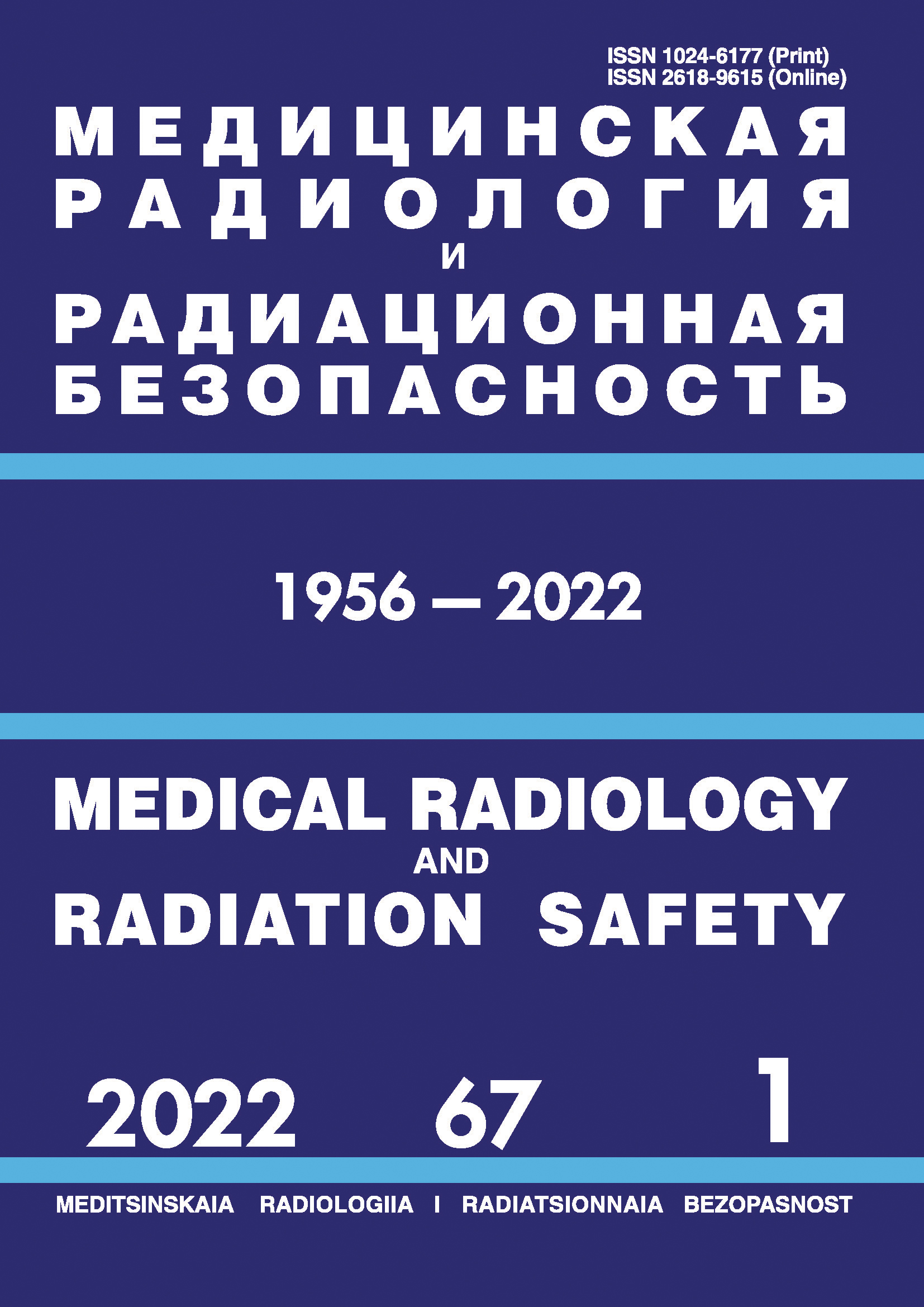employee
Institute of Biomedical Problems, Russian Academy of Sciences (Junior Researcher)
Russian Federation
employee
Russian Federation
employee
Institute of Biomedical Problems, Russian Academy of Sciences (Junior Researcher)
employee
Russian Federation
employee
employee
Institute for Biomedical Problems
employee
A.I. Burnasyan Federal Medical Biophysical Center (FMBC) FMBA
employee
Russian Federation
Purpose: Assessment of the role of various factors in the formation of radioresistance is an important section of radiobiology, radiation medicine, including radiation therapy for hematological oncological diseases. The quality of drinking water, as it turned out, can significantly affect the radio resistance. Against the background of studying the antiradiation properties of various types of water, differing in mineral and isotopic composition, the problem of the influence of tap water on the course of radiation injury remained underestimated. This circumstance determined the purpose of the work: to compare the effectiveness of the effect of fractionated total X-ray irradiation in lethal doses, simulating total therapeutic irradiation of oncohematological patients, when consuming tap water and highly purified artificially mineralized tap water in an experiment on mice. Materials and Methods: Female ICR (CD-1) mice were irradiated with moderately lethal doses of fractionated (daily 4 × 2.2 Gy and 4 × 2.3 Gy) X-ray irradiation. After exposure, half of the mice received tap water as drinking water, and the other half received artificially mineralized drinking water. Results: Keeping animals on tap water statistically significantly reduced the survival rate of mice under fractionated irradiation (χ2 = 3.88, p <0.05, log-rank test p = 0.049) compared with animals receiving artificially mineralized distilled water. In addition, in the group of mice that received tap water, an increase in the rate of death of mice and a lower safety of the group weight of animals during the development of acute radiation injury were noted. Conclusion: Tap water, used as drinking water, increases the damaging effect of radiation with fractionated X-ray irradiation of mice.
X-ray exposure, tap water, artificially mineralized distilled water, survival, mortality, mouse
1. Yagunov A.S., Reeves G.I., Tokalov S.V., Chukhlovin A.B., Afanassiev B.V. Animal Studies of Residual Hematopoietic and Immune System Injury from Low Dose/Low Dose Rate Radiation and Heavy Metals. Bethesda. MD: Armed Forces Radiobiology Research Institute, 1998. DOI:https://doi.org/10.13140/2.1.3584.0007.
2. Carpenter D.O., Bushkin-Bedient S. Exposure to Chemicals and Radiation During Childhood and Risk for Cancer Later in Life // J. Adolesc Health. 2013. V.52, № 5. P. 21-29. doihttps://doi.org/10.1016/j.jadohealth.2013.01.027.
3. Vacek A., Sikulová J., Bartonícková A. Radiation Resistance in Mice Increased Following Chronic Application of Li2CO3 // Acta Radiol. Oncol. 1982. V.21, № 5. P. 325-330. doihttps://doi.org/10.3109/02841868209134023.
4. Chlorinated Drinking-Water; Chlorination By-Products; Some Other Halogenated Compounds; Cobalt and Cobalt Compounds: IARC Monogr Eval Carcinog Risks Hum. International Agency for Research on Cancer (IARC) Working Group. Lyon, 1991. No. 52. P. 45-399.
5. Melkova K.N., Gorbunova N.V., Chernyavskaya T.Z., Baranov A.E., Pushkareva S.G., Frolov G.P. i dr. Total'noe obluchenie organizma cheloveka pri transplantacii kostnogo mozga // Klinicheskaya onkogematologiya. Fundamental'nye issledovaniya i klinicheskaya praktika. 2012. T.5, № 2. S. 96-114.
6. Sanitarno-epidemiologicheskie pravila i normativy SanPiN 2.1.4.1074-01 Pit'evaya voda. Gigienicheskie trebovaniya k kachestvu vody centralizovannyh sistem pit'evogo vodosnabzheniya. Kontrol' kachestva. Gigienicheskie trebovaniya k obespecheniyu bezopasnosti sistem goryachego vodosnabzheniya.
7. Kaplan E.L., Meier P. Non-Parametric Estimation from Incomplete Observations // J. Am. Stat. Assoc. 1958. V.53, № 282, P. 457-481.
8. Sacher G.A. On the Statistical Nature of Mortality, with Especial Reference to Chronic Radiation Mortality // Radiology. 1956. V.67, № 2. P. 250-258. doi:https://doi.org/10.1148/67.2.250.
9. International Guiding Principles for Biomedical Research Involving Animals. Geneva: CIOMS, 1985
10. Guidelines for Drinking Water Quality. 4th Edition. Library Cataloging in Publication Data, WHO. 2011 P. 584.
11. Van Trigt R. Lazer Spectrometry for Stable Isotope Analysis of Water: Biomedical and Paleoclimatological Applications. Groningen: University Library Groningen, 2002. P. 192.
12. Rahmanin Yu.A. Biofizika vody: kvantovaya nelokal'nost' v tehnologiyah vodopodgotovki, regulyatornaya rol' associirovannoy vody v kletochnom metabolizme, normirovanie bioenergeticheskoy aktivnosti pit'evoy vody / Pod red. Rahmanina Yu.A., Stehina A.A., Yakovlevoy G.V. M.: URSS, 2016. 352 s.
13. Ivanov A.A., Andrianova I.E., Mal'cev V.N., Shal'nova G.A., Stavrakova N.M., Bulynina T.M., Dorozhkina O.V., Karaulova T.A., Gordeev A.V., Bushmanov A.Yu. Vliyanie pit'evoy vody razlichnogo kachestva na intaktnyh i obluchennyh myshey // Gigiena i sanitariya. 2017. № 9. S. 854-860. DOI:https://doi.org/10.18821/0016-9900-2017-96-9-854-860.
14. Laissue J.A., Altermatt H.J., Bally E., Gebbers J.O. Protection of Mice from Whole Body Gamma Irradiation by Deuteration of Drinking Water: Hematologic Findings // Exp. Hematol. 1987. V.15, № 2. P. 177-180.
15. Ivanov A.A., Ushakov I.B., Kulikova E.I., Kryuchkova D.M., Severyuhin Yu.S., Vorozhcova S.V., Abrosimova A.N., Gaevskiy V.A., Sinyak Yu.E., Grigor'ev A.I. Legkoizotopnaya voda - sredstvo lecheniya ostroy luchevoy bolezni // Aviakosmicheskaya i ekologicheskaya medicina. 2013. T.47, № 5. S. 40-44.
16. Abrosimova A.N., Rakov D.V., Sinyak Yu.E. Vliyanie «legkoy vody» na razvitie pomutneniya hrustalika u myshey posle mnogokratnogo γ-oblucheniya v nizkih dozah // Aviakosmicheskaya i ekologicheskaya medicina. 2009. T.43, № 2. S. 29-32.
17. Kulikova E.I., Kryuchkova D.M., Severyuhin Yu.S., Gaevskiy V.N., Ivanov A.A. Radiomodificiruyuschie svoystva vody s ponizhennym soderzhaniem deyteriya i tyazhelyh izotopov kisloroda // Aviakosmicheskaya i ekologicheskaya medicina. 2012. T.46, № 6. S. 45-50.
18. Kryuchkova D.M., Andrianova I.E., Kovalenko M.A. i dr. Vliyanie mineraloorganicheskogo kompleksa na radiorezistentnost' myshey // Aviakosmicheskaya i ekologicheskaya medicina. 2013. T.47, № 5. S. 37-40.
19. Cantor K.P., Hoover R., Hartge P., et al. Bladder Cancer, Drinking Water Source, and Tap Water Consumption: a Case-Control Study // J. Natl. Cancer Inst. 1987. V.79, № 6. P. 1269-1279.
20. Ishidate M.Jr., Sofuni T., Yoshikawa K., Hayashi M., et al. Primary Mutagenicity Screening of Food Additives Currently Used in Japan // Food and Chemical Toxicology 1984. V.22, № 8, P. 623-636. doi.org/10.1016/0278-6915(84)90271-0.
21. Eltahawy N.A., Sarhan O.M., Hammad A.S., et al. Effects of Combined Exposure to Aluminum Chloride and γ-Radiation on Histological and Ultrastructure of Intestinal Paneth Cells // Radiat. Res. Appl. Sci. 2016. No. 9, P. 400-408. doi.org/10.1016/j.jrras.2016.05.007.





